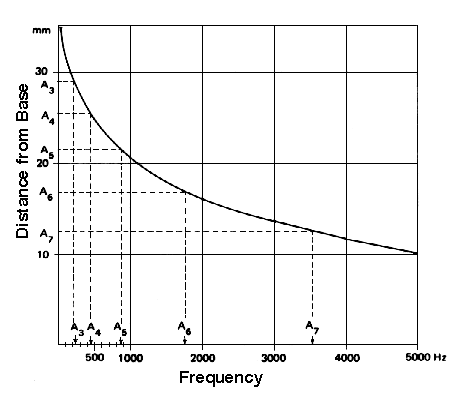
 |
Basilar Membrane |
Together with the organ of Corti, the main sensing mechanism of the ear. It is contained within the fluid-filled cochlea of the inner ear, and is approximately 1.3 inches (35 mm) long, coiled 2 1/2 times in a spiral. See cochlea for diagram.
Incoming vibrations set up a travelling wave along the membrane giving it a different maximum displacement for different frequencies as shown below. The bulging of the membrane creates a shearing motion for the hair cells of the organ of Corti, generating electrical potentials that stimulate the auditory nerve.
See also: Critical Bandwidth, Threshold Shift, Transducer, Volley Theory. Compare: Bone Conduction.

The bulging of the basilar membrane as a function of frequency (from F. Winckel, Music,Sound and Sensation, Dover, 1967, p. 90, used by permission; after L.A. deRosa, J.A.S.A, 1947, p. 623).

Position of the resonance maximum on the basilar membrane (after von Békésy) for a pure tone of frequency f. The figures A3 to A7 indicate the equivalent pitch positions in the western equal tempered scale; see Appendix C for further detail (from Roederer, Introduction to the Physics and Psychophysics of Music, Springer, 1975, p.22, used by permission). This spacing provides the basis for the logarithmic perception of frequency. See: Linear.